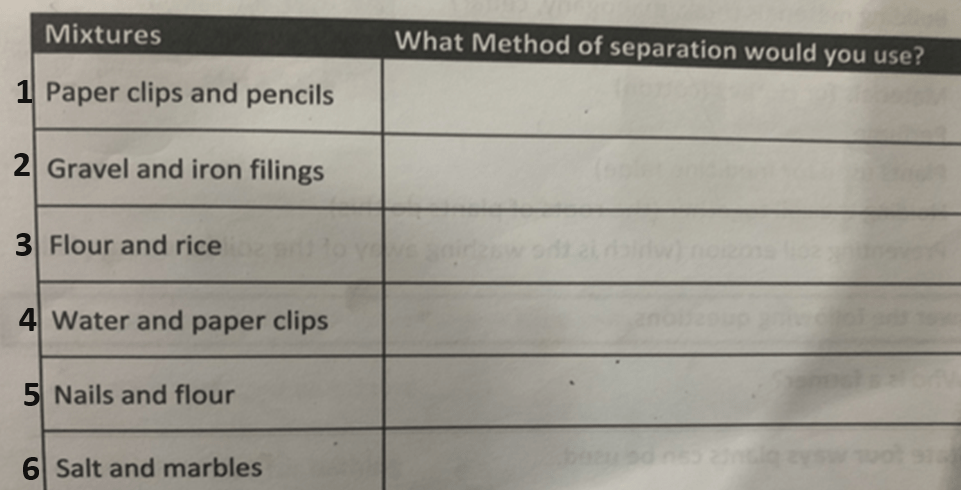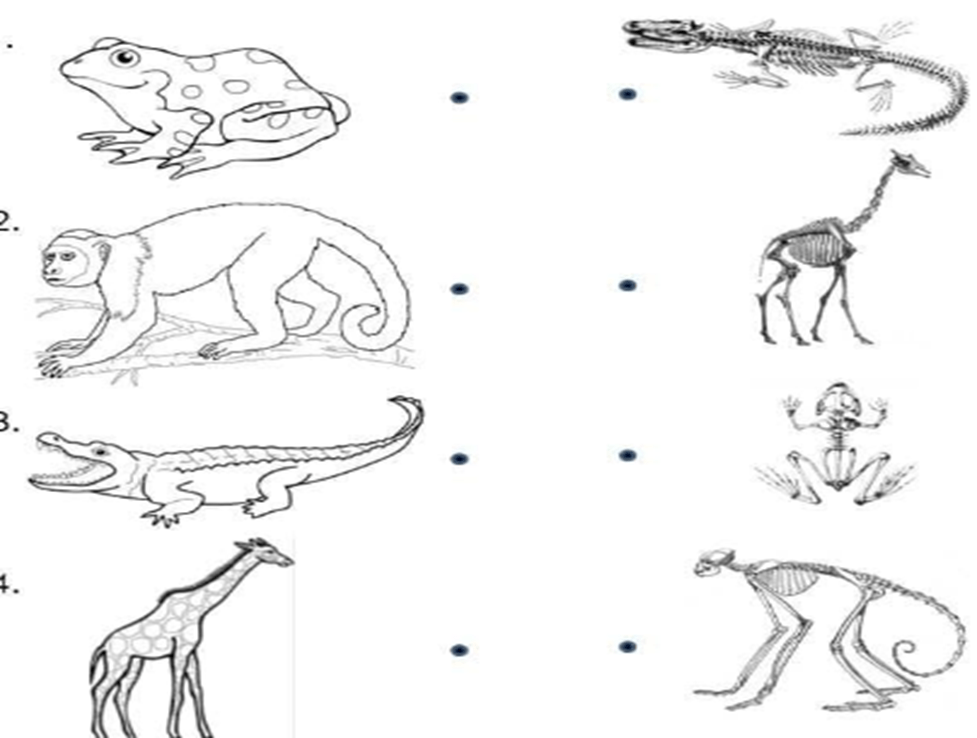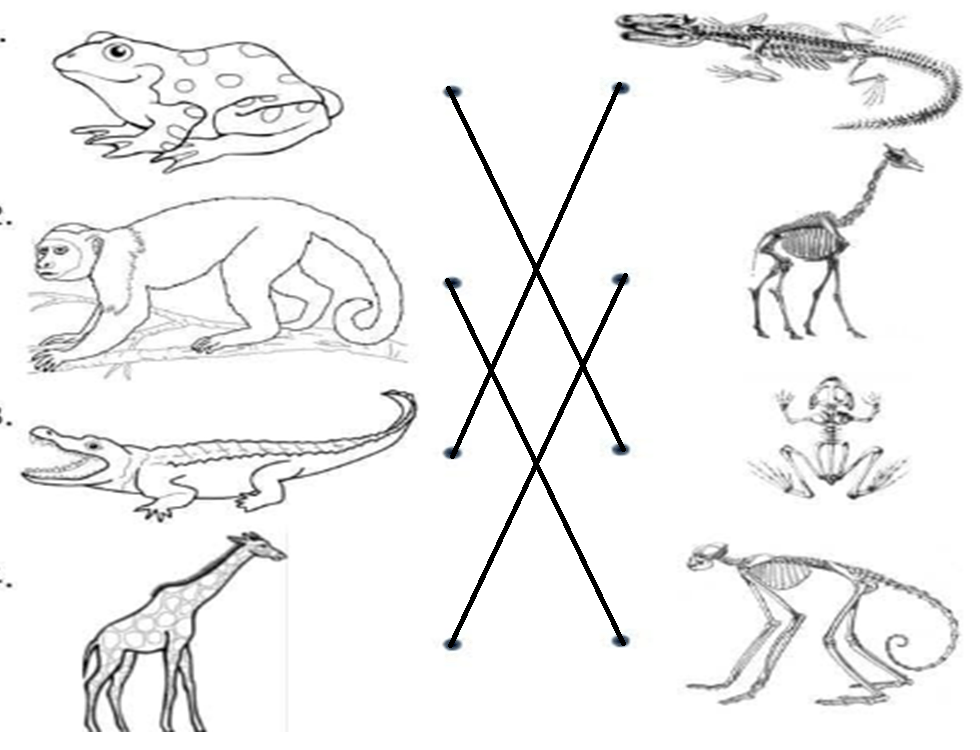What is an invertebrate
Animal without a backbone
- Things can be classified in _________________________ & ___________________________________ things.
Living and Non Living Things
A B=baby human has about __________ Bones, because at this stage tyhe bones aren't yet ___________. An adult has about _________bones.
300, fused, 206
What is a scientist
Someone who studies or has knowledge of science and how objects around us work

1. Magnet, handpicking
2. Magnet, handpicking
3. handpicking or sieving
4. magnet, handpicking or sieving
5. magnet, sieving
6. sieving or handpicking
A vine is an invertebrate. True or False
False. Vines are plants. Only animals can have backbones, or not have them, as the case may be.
- Name the characteristics of Living things. Living things can ____________________, _____________________, ____________________, ___________________, ___________________________ and ______________________________________
Eat, Breathe, Transpire, Grow, Move, Reproduce, pass waste
Tendons (fibrous tiisue) and Ligaments (bands of connective tissue) serve to .......
Protect the internal organs, bones and muscles in place.
Which local scientist is a NASA Engineer?
Dr. Camille Alleyne. She works as a sytems engineer for NASA's International space programme
What is a sieve used for
To separate two solids or mixtures of two different sizes eg flour & pebbles, sand & pebbles/gravel, salt & beans and flour & rice.
The bigger particles cannot pass through the holes in the sieve, remainng in place while the smaller particles can pass through the holes.
Name 5 invertebrates that you can find in the home
Insects (ants, cockroaches, bugs, butterflies, flies, mosquitoes)
Caterpillars, worms
Centipedes, millipedes, snails
Name 5 animals with exoskeletons
(Any insect)
Millipedes, centipedes,
crabs, snails, lobsters, prawn, shrimp, seahorses
A tendon is a fibrous connective tissue that attaches _____ to _______. Tendons may also attach muscles to structures such as the _______ A tendon serves to move the bone or structure. Major _____________are attached to bones.
muscle to bone
eyeball
muscle.
Which local scientist was a bacteriologist and what did he discover?
Dr. Lennox J Pawan, who discovered how rabies is transmitted. This led to a vaccine for rabies.
A sieves will contain holes of different sizes in it. True or False
False. Each sieve will contain equal sized holes. You can have sieves coming in varying sized holes.
5 invertebates in the zoo
Octopus, sqid, shrimp, Jelly fish
Crabs, lobsters
millipedes, centipedes, worms
Name 5 animals with endoskeletons
Any mammal
Fishes
Most reptiles and most amphibians
Birds
Bones/skeletons serve the following purposes:-
1. Hold the shape of the animal
2. Support the animal and help it to move
3. Protect vital organs
Which local scientist as an engineer, researched and developed a component used in flat screen technology today?
Dr ANdre Cropper developed the OLED technology and component used in flat screen TVs, phone screens and smart watches today
3 methods of separating mixtures are
Handpicking - best when one of the solids is large enough to be picked eg sand and shells; marbles and matchsticks, rice and stone
magnets - must have only one of the particles being attracted to metals
sieving- must have particles of different sizes to work
5 invertebrates in the farm
Millipedes, centipedes
Insects (ants, cockroaches, bugs, butterflies, flies, mosquitoes)
Caterpillars, worms, snails


True or false: Crabs have an exoskeleton
True
Which scientist was a professor at UWI who was an expert on fresh water fish?
Dr. Julian Kenny
what is an ecosystem
A community of living and non living things in an area. where the living things
- interact with each other and with non living things
-depend on each other to survive
- may be of different sizes
Scientists have discovered an object that sweats. Classify it as either Living or Non Living.
Living. Living things pass waste- SWEAT, URINE, FAECES.
Name 3 vital organs in the human body
Heart, brain, lungs, stomach, kidney, liver, skin, pancreas, intestines
What is an exoskeleton?
An exoskeleton is a hard covering on the outside of an animal that supports and protects its bodies.
How do scientists operate to make discoveries, what is the role/are the functions/duties of a scientist:
Observe and gather information through their 5 senses and wonder, conduct experiments, ask questions, share ideas, use tools, explore the world around them, listen to ideas, do research
name some examples of ecosystems
HOw are Living things different from non living things?
Non Living THings do not breathe eat transpire grow move reproduce or pass waste
4 Ways Scientists help us are
1. discover ways to protect the earth
2. grow more food
3. improve technology
4. improve health and medical care